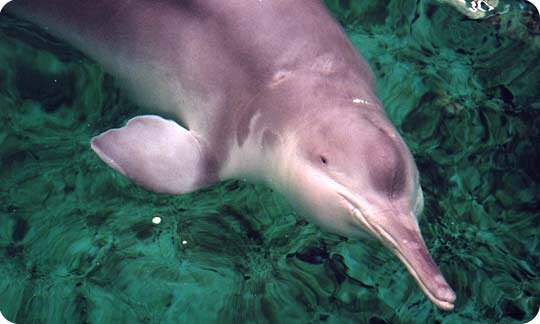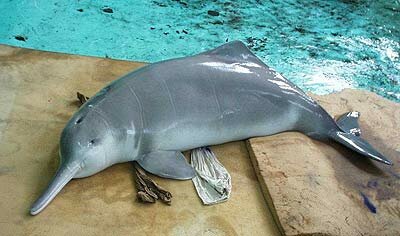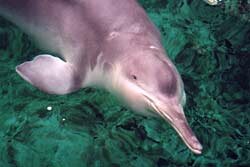Cetacean Investigation-"Wake of the Baiji" - Teacher's Guide

![]()
Documentary Slide Show Overview
earthOCEAN speak with scientist Robert Pitman, of the NOAA Southwest Fisheries Science Center in La Jolla, California. He recently returned from China, where he participated in an international expedition, searching for the critically endangered river dolphin called 'baiji'.
The Program
- Visits the Yangtze River in China, the home of a 20 million year old river dolphin called baiji (pronounced bye-gee).
- Visits the locations of the four species of river dolphins around the world.
- Explores some of the adaptations of the baiji to life in a shallow, muddy aquatic environment through imagery of Qi Qi (pronounced Chee Chee), a captive dolphin.
- Journeys down the Yangtze River with Pitman and his team, as they search for signs of this critically endangered dolphin.
- Follows Pitman as he describes the Yangtze River environment today, and how the dolphin lost its battle for survival.
- Explains how in just a few short decades, human pressures such as fisheries and pollution drove the baiji to extinction.
- Discusses the reality and finality of extinction.
- Discusses the choices we face if we are to prevent the extinction of other critically endangered cetacean species.
- Relates some of the continued threats faced by the Vaquita porpoise in the Gulf of California, Mexico. Will this be the next cetacean extinction and why?
- Explores the idea of the kind of world we are shaping for the future.
- Questions whether there is room for all the animals on the planet and a growing human population?
Viewing Ideas
Before Viewing
- Explain that whales, dolphins and porpoises belong to the order cetacea, which includes 86 species that come in a range of sizes, colors, and shapes. Whale and dolphin gallery Talk with students about cetaceans and introduce the distinct group of River Dolphins. Look at a map of the world and discuss the distribution of cetaceans and how they have evolved to exploit all marine and some freshwater habitats. Help students locate the range of the four species of river dolphins.
- Divide students into three/four groups. Advise students to take notes throughout the video slide show, specifically focusing on the following;
- How did the baiji adapt to exist in a river environment?
- What was the purpose of the baiji expedition?
- What were the greatest threats to the survival of the baiji?
- Is extinction an inevitable result of human progress?
- How is the extinction of the baiji 'a new kind of extinction'?
After Viewing
- Begin by giving students time to compare and discuss their notes among the group.
- Class discussion. Ask students how they feel about the extinction of the baiji.
- How do human values play a role in extinction?
- Do we have a responsibility to ourselves, to future generations, or the animals that share the planet to protect biodiversity?
- Can wildlife compete when people are just trying to make a living?
- Is large-scale economic growth compatible with the protection of biodiversity?
Classroom Activity
Objective
Utilize information gathered about extinction from 'Wake of the Baiji', from class discussion, and from internet research for a classroom debate that considers the positions of all 'stakeholders' in view of the likely extinction of the vaquita porpoise.
Materials
- Computer (Depending on accessibility, students can work independently, in pairs or groups.)
- Internet access
- 'Stakeholders' Handout sheet
Procedure
- Understanding cetaceans and their habitat helps scientists and policy makers organize research and conservation programs. Sometimes conservation efforts conflict with livelihoods, job security and the economic pursuits of governments. In this activity, students are assigned a stakeholders role on the issue of the critically endangered vaquita porpoise. Fight for survival at sea. (Students can pull stakeholder names out of a bag. This activity works best if students are assigned a role they would not necessarily choose or defend. This allows for the exploration and understanding of alternative views)
- Depending on access to computers, organize students into groups, providing each with a copy of the 'Stakeholders' Handout.
- Have students search online for information about the vaquita and information pertinent to their role as a stakeholder in the debate.
- Instruct students to thoroughly research their role, as well as the natural history, ecology and status of the vaquita. Research any examples where the interests of economy and conservation are working together to protect species. For example; some fisherman in Baja, Mexico are paid as whale watch guides, therefore it is in their own economic interests to protect the whales and their habitat.
- From their research, students will develop a 'perspective' that clearly expresses their position as a 'stakeholder'. Their job will be to try to convince others of their position, with a thoroughly researched argument.
- There will be 3 or 4 debates, depending on the size of the class. Students from each team will give a 4 - minute presentation/argument to the class on their perspective. Students in the audience will vote on which team they believe argued their case best, and the teacher will chair each debate. Representing their stakeholder', students will argue their perspective on the value of saving the vaquita from the same fate as the baiji - extinction. (NOTE: If possible, a guest speaker from the field of ocean/cetacean research will give students further insight and access to this field of science)
Activity Answer
Students use what they learned about the baiji in China as a catalyst for a class debate about extinction. Students see the connectedness between species survival and human induced pressures, and explore our responsibilities to other life on this planet, and the role of human values.
This activity gives students a real worldview of extinction, its causes and its implications. It challenges students to explore their own values in regard to the natural world, and to question how human population growth is shaping life on this planet and the relevance of science and conservation.
Related Resources
Classroom Application
The 'Wake of the Baiji' Activity program is specifically directed at Grades 9-12 Science, environmental education, political science, and ICT subject areas.
Lateral thinking allows activities encompassing whales, dolphins and porpoises collectively called cetaceans, to link into a wide range of secondary curriculum areas. An awareness of other animals, particularly the study of charismatic keynote species, is crucial for students to learn about the issues involved in conservation and how the choices we make affect the world around us. Learning about the lives of other animals changes our 'world view', fosters a sense of responsibility and encourages action. The topic of cetaceans fits most obviously into the science learning area. However, there is ample opportunity to incorporate whales and dolphins into the geography, English and art frameworks.
Handouts:
Links:
- VAQUITA.org - This website specifically addresses the conservation and research efforts related to the critically endangered Vaquita porpoise, found only in the northern reaches of the Gulf of California, Mexico.
- BAIJI.org - This website was dedicated to raising awareness about the plight of the baiji. Now the baiji is gone, there are other cetacean species, such as the finless porpoise that need help.
- River Dolphin Fact Sheet
- Article - "Fight for Survival at Sea" - Vaquita Porpoise faces extinction off Baja as fishing nets are blamed - San Diego Online
- Whale & Dolphin Gallery.
- earthOCEAN Educational Presentations
- NOAA Southwest Fisheries Science Center in La Jolla, CA USA.
Classroom Activity Author
Genevieve Johnson has taught middle and high school students in the area of Environmental Education for over 12 years. She has also spent five years as a cetacean field researcher on an around the world science and education expedition. As well as teaching in a classroom, Genevieve designed the 'Class from the Sea' and 'Ocean Encounters' programs, designing curriculum and linking with students around the globe from the research vessel.

 Robert Pitman is a scientist with the
Robert Pitman is a scientist with the  "Qi Qi" - A Yangtze River Dolphin.
"Qi Qi" - A Yangtze River Dolphin.